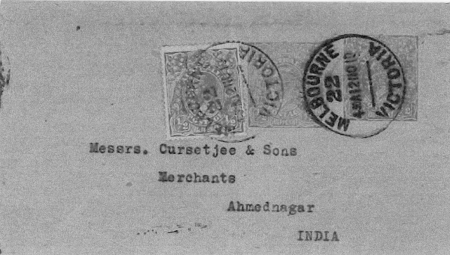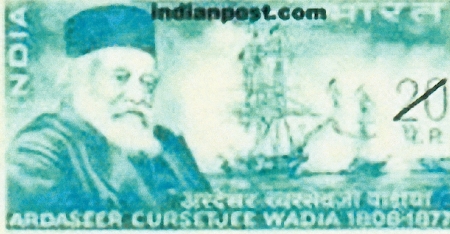I have to admit that this insignificant cover probably has little or no relationship to the person to be described in this paper, other than they both resided in India, and had a common surname. The cover shows 3 green ½d KGV head stamps, two of which appear imprinted copies, with 2 postmarks of MELBOURNE/ 22/ 430A 12 NO 19/ VICTORIA. It was addressed to Messrs. Curtsejee & Sons, Merchants, Ahmednagar, India. The reverse was not seen (Figure 1).

Ardaseer Cursetjee Wadia had the unique honour of being the first in many fields during the Victorian era. He was the first Indian who had the honour to be elected a fellow of the Royal Society, London and was the first to introduce lighting by gas in Bombay. He was celebrated by the Indian Post and Telegraphs Department with a stamp issued May 27, 1969, as shown in Figure 2.

Ardaseer Corsetjee Wadia belonged to the well-known family of Lowjee Wadia who had distinguished themselves as the noted ship-builders of Bombay. He was born on the 6th October, 1808, and his father Cursetjee Rustomjee was a master builder in the Dockyard at Bombay. After receiving his early education, he joined the dockyard in 1822 at the very young age of 14. He was very much interested in marine engineering and especially in the working of steam engine. He went to England, where he constructed a steam engine, which he sent to India to be fitted in a boat of his own building, the small 60 ton Indus, which was launched in 1833. His flair for the steam engine and mechanical gadgets was such that he was the first to install steam pumps on the island of Bombay.
These pumps provided sufficient water to a small fountain thereby demonstrating to his countrymen the great advantages which might be derived from introduction of steam as a means of power, which could be used successfully for irrigation. The great interest Ardaseer Cursetjee Wadia took in engineering led him to introduce gas lighting in Bombay. On 10th March, 1834, he lighted his bungalow and his gardens at Mazagoan with gas, and the governor of Bombay and people from all parts of the town gathered to see the novel experiment. Ardaseer was for some time a professor in the Elphinston Institution in Bombay teaching mechanical and chemical sciences. In 1839, at the age of 31, he traveled overland to England to further his studies of marine steam power. He recounted his journey in The Diary of an Overland Journey from Bombay to England, which was published in London in 1840
During his stay in England, he had the privilege of being introduced to the Marquis of Northampton, President of Royal Society as well as other distinguished members of the Society.
His knowledge of the steam engine as applied to navigation, and the efforts he made for promotion of sciences and the useful arts in his country, were recognised by the Royal Society on the 27th May, 1841 when he was the first Indian elected a Fellow of this august Society. Ardaseer was one of the dignitaries from India who attended the wedding of Queen Victoria.
On his return from England, he was appointed as chief Engineer and Inspector of machinery at the Steam Factory at Bombay by the Court of Directors of the East India Company, in preference to several English candidates. This was very unusual at that time as Ardaseer had to supervise the work of English employees at the docks. He occupied this post until 1st August, 1857 when he retired from the service. Previously, in 1837, he was elected a non-resident member of the Royal Asiatic Society of England, and in 1855 he was elected a justice of the peace. His hobby was to introduce novelties in the city of his birth, for he was the first to introduce the sewing machine, photography and electro-plating in Bombay. After a distinguished scientific career and a useful life, Ardaseer settled down at Richmond, England and passed the remaining years of his life there. He died on the 16th November, 1877 at Richmond.
This paper is based on the discussion of Ardaseer Cursetjee in Wikipedia.